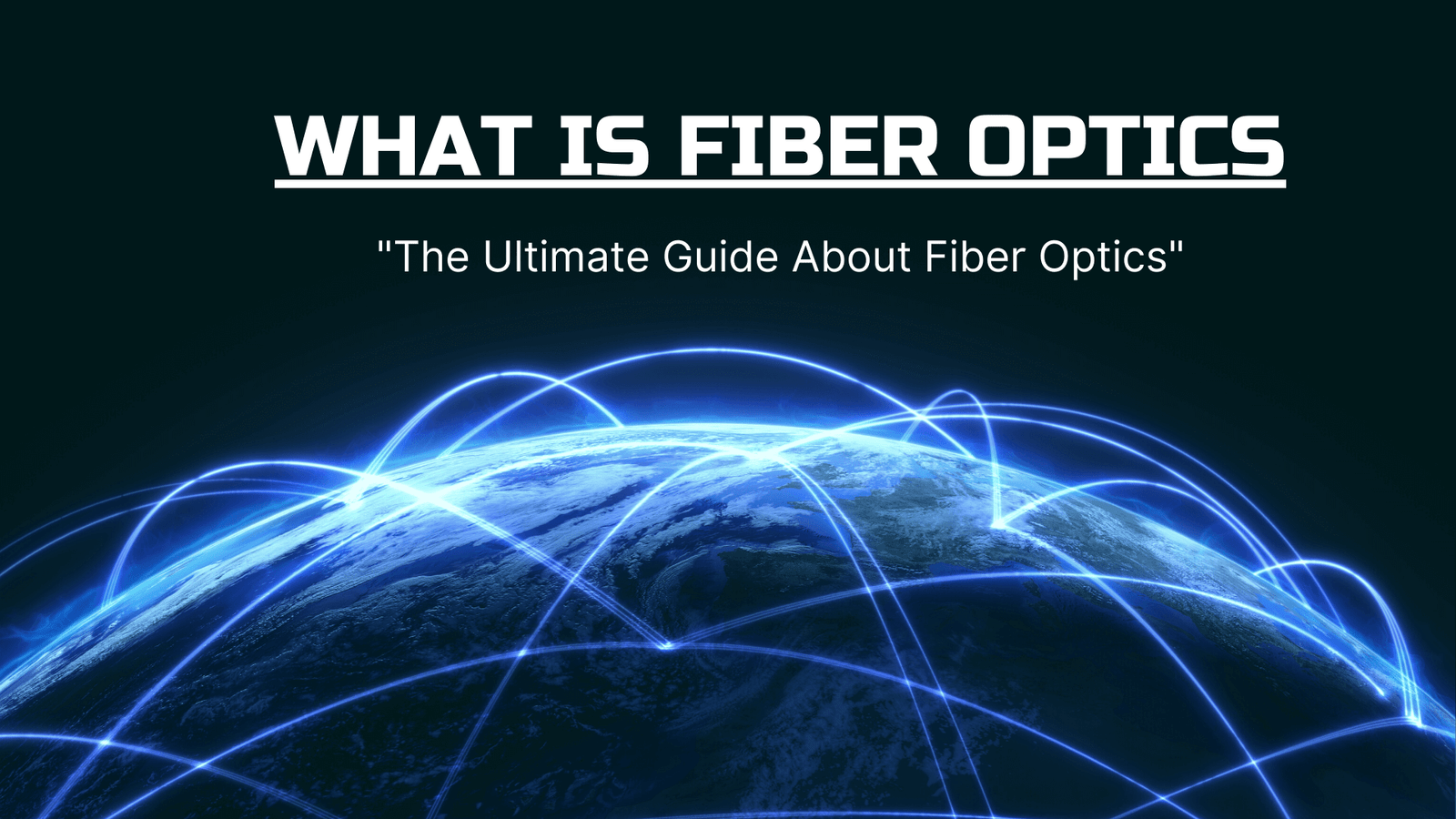What Is Fiber Optics?
Fiber optics Is a technology that makes use of thin and bendy glass or plastic fibers to transmit light indicators over long distances, frequently for statistics transmission, photograph transmission, or lighting residences and groups.
Fiber optic technology is used extensively in telecommunications systems. Fiber optic cables carry telephone signals, Internet data, and cable television signals across long distances at breakneck speeds – significantly increasing the capacity of telephone and Internet systems.
Fiber optics has many uses in medicine. Fiber optic cables can carry images of the inside of the body for surgical procedures or be used as images during medical imaging tests. Fiber optic technology is also used to develop novel medical treatments, such as cancer therapies.
Fiber optics will likely play a more and more crucial part in our lives over the coming years. Researchers are exploring methods of using fiber optic cables for transmitting energy and planning a name for this generation to develop an “superfast” net device typically quicker than currently exists
Why Fiber Ops Matter Nowadays
Humans rely increasingly on the internet for non-public and expert desires alike; therefore, the call for for quicker and extra dependable internet connections has also skyrocketed; fiber optics is here to provide this crucial link among computer systems and people around the globe.
Fiber optics is a method for transmitting records using light pulses transmitted over thin, flexible glass or plastic fibers, capable of imparting ultra-high-pace net connections which can be a great deal faster and greater dependable than conventional copper twine connections.
Fiber optic internet connections offer many blessings over conventional cable internet get admission to answers, with A few splendid ones include:
Increased Speed
Increased Speed Fiber optic internet connections offer one of the primary benefits of fiber optics: faster data delivery speeds of up to 1 gigabit per second (Gbps). This speed makes fiber optic internet far faster than average broadband internet speeds in the United States, which average around 25Mbps.
Additional Reliable Connections
Fiber optic technology also offers increased reliability. Because its cables are less susceptible to interference, fiber optic internet connections are less likely to experience disruption due to inclement weather or power outages.
Increased Quality
Fiber optic internet connections offer improved quality. Fiber optic cables are composed of glass or plastic instead of being susceptible to electromagnetic interference like copper cables are, resulting in more precise and consistent connection speeds for the Internet.
Increased Bandwidth
Fiber optic internet connections also feature increased bandwidth, meaning more data can be transferred per second – perfect for activities that demand high amounts of data, such as streaming video or downloading large files.
Reduced Latency
A key benefit of fiber optic cables is reduced latency. Latency refers to the time it takes data to travel from point A to B; due to their meager latency rates, data travels quickly between locations – making fiber optics ideal for activities that rely on real-time updates, like online gaming or video conferencing.
Cutting-Edge Technology
Cutting-Edge Technology Fiber optics is an innovative technology with numerous applications. What are its applications?
Fiber optics have numerous applications in telecommunications, computing, medicine, and sensing – from long-distance data transmission over long distances, connecting devices, and creating high-speed data connections to medical imaging/surgery/diagnosis and sensing environmental/industrial conditions.
How do fiber optics work?
Fiber optics is the science of light transmission through very fine glass or plastic fibers. It can be found everywhere, from telephone lines and cable TV to high-speed internet connections and medical devices, serving various communications needs.
The working of fiber optics is also complex. Light waves contain both electric and magnetic fields that oscillate at right angles to one another in their travel direction. Whilst those waves come across substances along with glass, they motivate the electrical field to push and pull on electrons in glass atoms, causing electrons to transport, generating their own magnetic fields.
Dielectric Waves
Dielectric waves result from combining original light waves with those caused by electron movement.
Dielectric waves travel through glass at a speed determined by its properties. Still, in a fiber optic cable, they come into contact with another material with a lower index of refraction, such as air, which causes their dielectric waves to bend as they enter it thus altering their path as they approach their destination.
Bending is determined by factors including the angle of incidence (the angle at which light waves strike the side of a fiber), differential refractive indexes, and wavelength.
Dielectric waves travel through the air, refracting at every boundary between air and glass-like water through pipes. As it progresses down fiber optic cables, it bounces off walls en route – effectively keeping it within its boundaries while continuing its journey down.
At every bounce, a small portion of a wave’s energy is lost due to frictional forces and loss, leading to gradual weakening as it travels along its course. Yet its strength may remain sufficient for transmission for some distance before falling below a threshold needed for efficient transmission.
At the end of a fiber, dielectric waves reach a material with a high index of refraction – for instance, another piece of glass – where they encounter resistance.
What Are the Challenges of Fiber Optics?
Fiber optics refers to transmitting data using light pulses through an optical fiber medium, typically for various applications like telecommuting, computer networking, and medical imaging. Telecommunications, computer networking, and medical imaging are just a few examples of applications of radio frequency (RF). Its applications range from telecommunicating between sites to computer networking and medical imaging applications.
Fiber optic wiring offers several distinct advantages over its copper equivalent; however, its implementation poses unique challenges that must be considered before moving forward with installation.
Attenuation
A main challenge associated with fiber optics, attenuation refers to signal strength reduction over distance due to material properties in optical fiber, which cause light waves to scatter and be absorbed as they travel through.
Dispersion
A major challenge associated with fiber optics is dispersion, the spreading of light over time due to differing refractive index values in core and cladding materials, causing light waves to travel at various speeds across the fiber. This causes signal distortion over long distances as light travels at differing rates resulting in signal degradation over time.
Connectivity
Fiber optics also poses challenges when it comes to connectivity. Though optical fibers can be joined, their connections aren’t as sturdy as that between copper wires – making it challenging to join two pieces of cable of different sizes or types together.
Cost
One of the primary challenges presented by fiber optics is cost. Though initial installation costs can be substantial, ongoing maintenance expenses tend to be lower – long-term costs tend to be less than traditional copper wiring; yet for some organizations, the costs associated with cable and equipment remain an obstacle.
Maintenance
Finally, fiber optics require more maintenance than traditional copper wiring due to being fragile optical fibers that can easily become damaged from bending, crushing, or other forms of stress. This makes implementing and managing fiber optic networks challenging.
FAQs about What is Fiber Optic
Fiber optic refers to transmitting data using thin glass or plastic fiber strands. These fibers can carry large amounts of information through light signals. By utilizing the principle of total internal reflection, the light signals bounce within the fiber, traveling long distances without significant loss or interference. This technology has emerge as the backbone of present day telecommunications structures.
Fiber optic operates based on transmitting data through pulses of light. When data is sent, it is converted into light signals using a device called a transmitter. These signals travel through the fiber optic cables, bouncing off the walls of the fiber due to total internal reflection. At the receiving end, a receiver device converts the light signals back into the original data format. This process allows for high-speed and reliable data transmission.
Fiber optics offer numerous advantages over traditional copper cables. Here are some key benefits:
High-speed data transmission: Fiber optic technology offers fast data transmission speeds that reduce internet latency.
Greater bandwidth: Fiber optic bandwidth facilitates transmitting large amounts of data at one time, supporting multiple users and heavy data-intensive applications.
Longer distances: Fiber optic signals have greater distance capabilities compared to copper cables, making fiber ideal for long-distance communication applications such as long-haul business trips or travel.
Immunity to electromagnetic interference: Optics is unique among communications technologies because its immunity to electromagnetic noise ensures reliable data transmission even under conditions with extreme electromagnetic disturbance. Copper cables cannot match fiber optics’ reliability when exposed to high electromagnetic levels in a hostile environment.
Security: Fiber optic cables can be difficult to tap into or intercept, providing more secure communication channels than their traditional cable counterparts.
Fiber optic technology has quickly become one of the go-to methods for internet Fiber optic connectivity offers lightning-fast speeds and superior performance compared to other technologies, making it increasingly attractive to ISPs as an ISP service provider. ISPs increasingly deploy fiber networks for offering fast internet to homes, businesses, and entire cities – especially as its ability to handle large amounts of data makes fiber ideal for bandwidth-intensive activities like streaming video content online gaming, and cloud computing.
No, fiber optic isn’t limited to internet communication alone. While its primary use lies with internet access, fiber optic can also be found in several other areas: telecom for long-distance communication between telephone exchanges as well as TV broadcast signals transmission; medical imaging applications, military applications, and industrial sectors that rely on reliable high-speed data transfer for operations or projects where fast transmission speed and secure transmission of data are key features; industrial sectors using fiber optic for data transfer applications are other examples.
Fiber optic cables boast many advantages over copper ones, which makes them the preferred choice in modern communication networks. Here is a comparison:
| Factor | Fiber Optic | Copper Cables |
|---|---|---|
| Speed | Offers extremely high-speed data transmission | Slower compared to fiber optic |
| Bandwidth | It provides a significantly larger bandwidth | Limited bandwidth capacity |
| Distance | Capable of long-distance transmission with minimal signal loss | Signal quality degrades over long distances |
| Interference | Immune |




